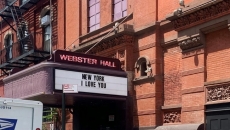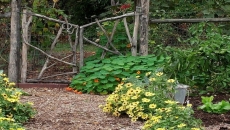Neither evening stocks nor jasmine tobacco are particularly worthy plants by day. But as darkness falls, the petals of each of these flowers unfurl to release a delicious, heavy scent.
Jasmine tobacco’s petals unfold colorful or pure white trumpets, the latter of which especially glow in the moonlight. The small white petals of evening stocks shine like little, bright stars. These two unrelated plants make congenial companions for you and each other on summer nights.
TWO PLANTS FOR NIGHT-TIME FRAGRANCE
Jasmine tobacco is one of a few species of nicotiana (pronounced nee-KO-shee-ay-na), botanically Nicotiana alata. (Yes, the word “nicotiana” does look like “nicotine,” and smoking tobacco is another nicotiana species.)
All species of nicotiana are in the nightshade family and, like their relatives, tomatoes, eggplants and peppers, they demand a rich, warm soil in the sun. For earliest flowers, sow the seeds indoors a few weeks before the last spring frost.
Jasmine tobacco is an annual, each plant forming a rosette of leaves at ground level and a flowering spike a couple of feet high, or more. New varieties have been bred which are more compact and which bloom in daylight, hopefully with no loss of scent.
Stocks represent two species, one grown mostly for its showy flowers and the other for its nocturnal aroma. The scented stock, known as evening or night-scented stock, is botanically Matthiola bicornis.
Evening stock is an annual that blooms from July through September. In contrast to jasmine tobacco, evening stock is a low-growing, straggly plant, a ball of wiry stems with small leaves and flowers. The wilted remains of the previous night’s flowers and the unopened buds of flowers for nights to follow are not much to look at by day.
Another plant called “stock” but more commonly called hoary stock or tenweeks stock is, botanically, Matthiola incana. This one yields colorful, showy spikes of blossoms, also with fragrance.
AT THEIR BEST AT NIGHT
Because jasmine tobacco and evening stock are not at their best by day, consider hiding these Cinderellas among showier flowers. A nice companion for stocks is gazania, which provides just enough contrast to complement each plant. Like stock, gazania is low-growing with thin petals, but its flowers are large, solitary, sunny-yellow daisies. Keep gazania and stocks near the front of a sunny bed, where they will not be shaded or hidden by taller plants.
Tall, spiky jasmine tobacco needs to be placed near the back of a bed for visual balance. Fill the spaces jasmine tobacco will leave bare by day by combining it with other tall flowers such as large delphiniums or large zinnias and asters. In the evening, white jasmine tobacco flowers will come into view as the day-bloomers recede into the darkness.
Plant jasmine tobacco and evening stock where they can be enjoyed on summer nights. Outside my back door, I once had a small, semicircular flower bed that was home to both these night-scented plants. When atmospheric conditions were right, the fragrance could make you delirious. I am not sure what exactly those optimal atmospheric conditions were, but the typical calm summer night seemed to fill the bill. On such nights, the heavy aroma would gather beneath the window just above the flower bed, waiting to be wafted indoors by the slightest breeze.
That flower bed is gone, but a new one will be home to these plants next year, with delirious summer nights to follow.
___
Lee Reich has been writing a gardening column for The Associated Press for nearly 20 years. He has worked in plant and soil research with the U.S. Department of Agriculture and Cornell University. His ``farmden" — more than a garden, less than a farm — in upstate New York is a testing and demonstration ground for techniques in soil care, pruning, and growing fruits and vegetables. His books include “The Pruning Book” and “Weedless Gardening.” He blogs at http://www.leereich.com/blog and can be reached at garden@leereich.com.






